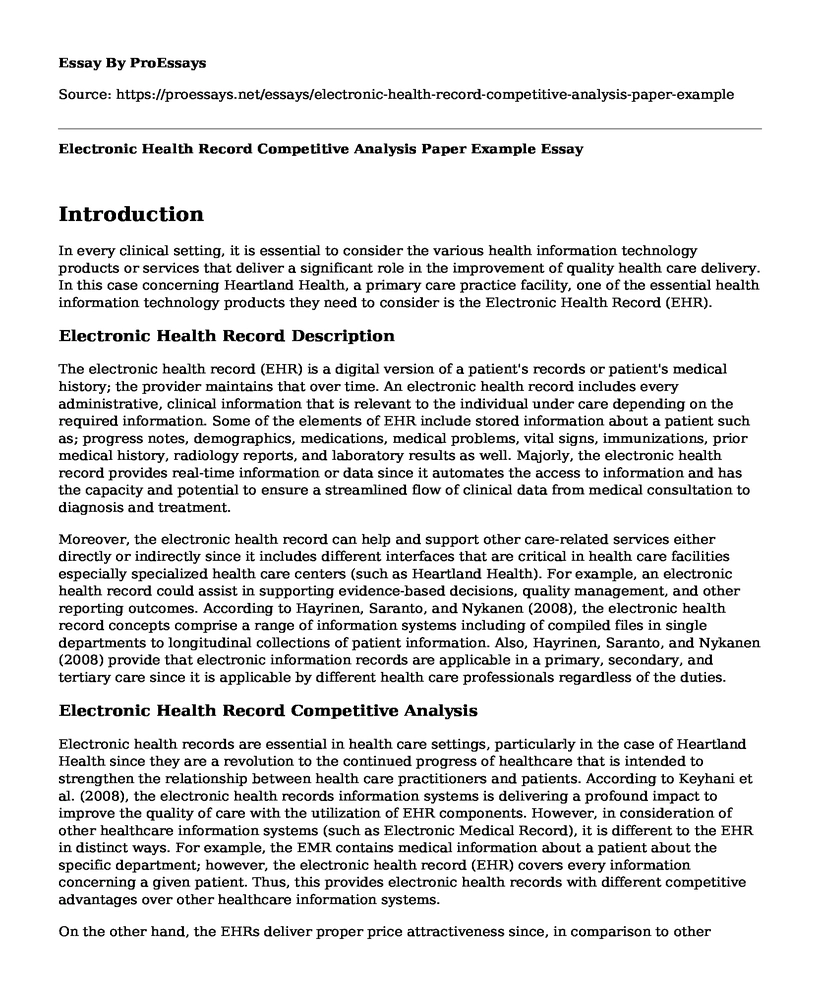Introduction
In every clinical setting, it is essential to consider the various health information technology products or services that deliver a significant role in the improvement of quality health care delivery. In this case concerning Heartland Health, a primary care practice facility, one of the essential health information technology products they need to consider is the Electronic Health Record (EHR).
Electronic Health Record Description
The electronic health record (EHR) is a digital version of a patient's records or patient's medical history; the provider maintains that over time. An electronic health record includes every administrative, clinical information that is relevant to the individual under care depending on the required information. Some of the elements of EHR include stored information about a patient such as; progress notes, demographics, medications, medical problems, vital signs, immunizations, prior medical history, radiology reports, and laboratory results as well. Majorly, the electronic health record provides real-time information or data since it automates the access to information and has the capacity and potential to ensure a streamlined flow of clinical data from medical consultation to diagnosis and treatment.
Moreover, the electronic health record can help and support other care-related services either directly or indirectly since it includes different interfaces that are critical in health care facilities especially specialized health care centers (such as Heartland Health). For example, an electronic health record could assist in supporting evidence-based decisions, quality management, and other reporting outcomes. According to Hayrinen, Saranto, and Nykanen (2008), the electronic health record concepts comprise a range of information systems including of compiled files in single departments to longitudinal collections of patient information. Also, Hayrinen, Saranto, and Nykanen (2008) provide that electronic information records are applicable in a primary, secondary, and tertiary care since it is applicable by different health care professionals regardless of the duties.
Electronic Health Record Competitive Analysis
Electronic health records are essential in health care settings, particularly in the case of Heartland Health since they are a revolution to the continued progress of healthcare that is intended to strengthen the relationship between health care practitioners and patients. According to Keyhani et al. (2008), the electronic health records information systems is delivering a profound impact to improve the quality of care with the utilization of EHR components. However, in consideration of other healthcare information systems (such as Electronic Medical Record), it is different to the EHR in distinct ways. For example, the EMR contains medical information about a patient about the specific department; however, the electronic health record (EHR) covers every information concerning a given patient. Thus, this provides electronic health records with different competitive advantages over other healthcare information systems.
On the other hand, the EHRs deliver proper price attractiveness since, in comparison to other systems such as the EMRs, the EHRs offer activities, and benefits the patients as well the health care practitioners thus a cost-cutting strategy. According to Richards, Prybutok, and Ryan (2012), one of the competitive advantages surrounding EHRs is its ability to provide advanced and quality care. Therefore, in terms of product rating, the electronic medical record health information technology as gaining higher rates as the healthcare setting is evolving daily. In conclusion, the electronic medical record delivers a high patient experience that is providing it with the most significant competitive advantage considering that not only the patients are benefiting but the staff as well. There is quick access to patient records delivering more efficient and coordinated care which is essential in attracting and retaining customers and generating sales for Heartland Health primary care center.
References
Hayrinen, K., & Nykanen, P., & Saranto K. (2008). Description, composition, content, usage, and influences of electronic health records: a review of study literature. International publication of medical informatics, 77(5), 291-304. Doi: 10.1016/j.ijmedinf.2007.09.001
Keyhani, S., Hebert, P. L., Ross, J. S., Federman, A., Zhu, C. W., & Siu, A. L. (2008). Electronic health record elements and the quality of care. Medical care, 1267-1272.
Richards, R. J., Prybutok, V. R., & Ryan, S. D. (2012). Electronic medical records: tools for competitive advantage. International Journal of Quality and Service Sciences, 4(2), 120-136. Doi: 10.1108/17566691211232873
Cite this page
Electronic Health Record Competitive Analysis Paper Example. (2022, Dec 06). Retrieved from https://proessays.net/essays/electronic-health-record-competitive-analysis-paper-example
If you are the original author of this essay and no longer wish to have it published on the ProEssays website, please click below to request its removal:
- Prevention of Breast Cancer in the United Kingdom and Iran
- Essay Sample on the Impact of the Internet in Society
- Research Paper on Ebola Disease
- The Use of EBP Models in Nursing Decision Making - Essay Sample
- Malpractice in Nursing Essay Example
- Essay Sample on Thyroid Disease: Prevalent Health Risk in Adults 35-65
- Discovering Individuality: An Essential Part of Medicine - Essay Example







